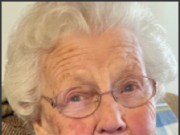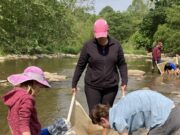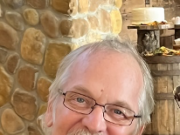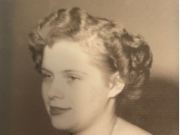Mantua – A fortunate group of Crestwood students got the rare opportunity to participate in the excavation of a Civil War Military Prison. Johnson’s Island, a 300-acre island on the coast of Lake Erie, is located three miles from the city of Sandusky, Ohio. It served as a POW depot for Confederate Officers from 1862 through 1865. Throughout that time period, over 10,000 officers were confined on the island. Over 300 died while imprisoned there, and are commemorated at the island’s Confederate Cemetery. This group of fifth and sixth graders got the rare opportunity for hands-on participation in an actual archaeological dig. In addition to learning basic archaeological techniques, the students worked together, documenting their findings in writing and sharing them aloud with the greater group.
Dr. David Bush, Professor of Anthropology and the Director of the Center for Historic & Military Archaeology at Heidelberg University, began investigations at the Johnson’s Island Civil War Prison Site in 1988. Since 1994, Heidelberg University has conducted undergraduate and graduate summer field schools at the site, under his guidance. For the last 17 years, Dr. Bush has led the Experiential Learning Program, which gives students in grades five through twelve the unique opportunity to participate in a real-world archaeological dig. “Many professors don’t like to have children’s’ participation because they think artifacts will be damaged,” acknowledged Dr. Bush. “I feel that as long as they are supervised, they can participate.”
At the start of the day, the group met with Dr. Bush in the Confederate Cemetery to investigate the area and ask questions. After being transported the short distance to the work site, this group of fifth and sixth graders were then divided into four groups and assigned a specific excavation unit to work on for the day. The group convened under the large white weather port, which protected the excavation area from the elements and housed Dr. Bush’s makeshift field office. Dr. George, an adjunct professor at Heidelberg, demonstrated proper excavation techniques. With a PhD in Curriculum Instruction, she is particularly interested in how kids learn differently in context, compared to how they typically learn in the classroom. “Kids are more inquisitive and observant than most adults. Working in the field helps them use their senses more — like feeling textures and identifying colors of the items they unearth — much more than they would in a classroom.” Dave, a retired teacher, joined Dr. George and Aaron, a graduate student, who also helped supervise the groups. “This is a unique opportunity,” Dave shared. “Very few places let kids in an active site to help them learn history and how they fit in. It’s really something when a 12 or 13-year-old gets excited about finding a piece of rock or a brick. And I get excited because the kids get excited to be here.”
The student groups got to work scraping the soil, carefully working it toward themselves with trowel. They used scoops to place the excavated soil into five gallon buckets, including any roots, rocks, dirt or bugs they encountered. The buckets were coded to coincide with the area the soil was excavated. Once the buckets were filled, they were taken outside where another team screened the excavated soil through a similarly coded screen. With the help of a volunteer, students identified and set aside all recovered cultural material, which included glass shards, metal, flint, ceramic and bone fragments. Throughout the course of the day, several items of special interest, called field specimens, were found. Those items, which included unusual glass and ceramic shards, were cataloged individually, with the student’s name permanently associated with the artifact in the site catalogue at the Archaeological Laboratory at Heidelberg University.
Two groups excavated while two teams screened the excavated soil and bagged the specimens throughout the morning. All groups had lunch on-site, where they had the opportunity to hear actual prisoner diary entries and prison documents from the prison. After lunch, the teams switched positions, with the morning’s excavators taking a turn screening, giving the screeners time to excavate. Students dug through the plow zone, stopping when they reached the subsoil, since more skill is required when working at this lower depth.
At the end of the afternoon, the groups sorted through the variety of items they found, completing daily field notes. Under Dr. Bush’s direction, students recapped their day, which began with the observations and hypotheses gleaned in the cemetery. They studied primary resources, including prisoner diary entries and letters. They dug, screened and classified materials and recorded their data. Afterwards, the groups presented their findings to the larger group. In total, they recovered 418 artifacts. Previous digs have unearthed gold buttons, an intact toothbrush handle, a piece of table knife, and a variety of prison craft: carved buttons, rings, and other decorative items prisoners made to send to relatives back home.
This program through Heidelberg University is the only one of its kind in the area. Programs run from September through November and from March through June, and typically involve a pre-field visit and a site excavation. This program is available to students in grades five through twelve, although the Crestwood visit was not a school-sponsored activity. The weekday trip was organized by several parents; based on the success of the valuable experience, they hope that the Johnson’s Island Dig will become an annual field trip for Crestwood students.
After the Civil War, most of the prison buildings were auctioned off and the land was used for farming and quarrying. A resort business operated briefly in the 1880s, but eventually failed. Residential building on Johnson’s Island began in the 1950s, and much of the island is privately owned. A portion of the prison compound and all of Fort Johnson have been set aside for long term preservation by a private landowner. The Cemetery is the only part of the prison that is open to the public. For more information on Johnson’s Island, visit www.johnsonsisland.org. For more information about the Confederate Officers’ prison on Johnson’s Island, visit www.youtube.com/watch?v=F4MppkqUW9Q.












